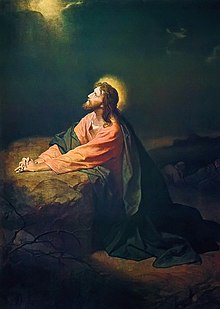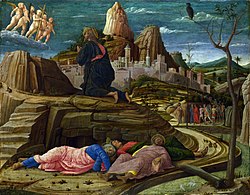What Was The Cup In The Garden Of Gethsemane
Episode from the life of Jesus Christ

The Agony in the Garden of Gethsemane was an episode in the life of Jesus which appears in the four canonical gospels, between the Farewell Discourse at the conclusion of the Last Supper and Jesus' arrest.[1]
Gospel narratives [edit]

According to all four canonical Gospels, immediately after the Last Supper, Jesus took a walk to pray. Each Gospel offers a slightly different account regarding narrative details. The gospels of Matthew and Mark identify this place of prayer as Gethsemane. Jesus was accompanied by three Apostles: Peter, John and James, whom he asked to stay awake and pray. He moved "a stone's throw away" from them, where he felt overwhelming sadness and anguish, and said "My Father, if it is possible, let this cup pass me by. Nevertheless, let it be as You, not I, would have it." Then, a little while later, he said, "If this cup cannot pass by, but I must drink it, Your will be done!" (Matthew 26:42; in Latin Vulgate: fiat voluntas tua ). He said this prayer thrice, checking on the three apostles between each prayer and finding them asleep. He commented: "The spirit is willing, but the flesh is weak". An angel came from heaven to strengthen him. During his agony as he prayed, "His sweat was, as it were, great drops of blood falling down upon the ground" (Luke 22:44).
At the conclusion of the narrative, Jesus accepts that the hour has come for him to be betrayed.[2]
Tradition [edit]

In Roman Catholic tradition, the Agony in the Garden is the first Sorrowful Mystery of the Rosary and the First Station of the Scriptural Way of The Cross (second station in the Philippine version). Catholic tradition includes specific prayers and devotions as acts of reparation for the sufferings of Jesus during His Agony and Passion. These Acts of Reparation to Jesus Christ do not involve a petition for a living or dead beneficiary, but aim to "repair the sins" against Jesus. Some such prayers are provided in the Raccolta Catholic prayer book (approved by a Decree of 1854, and published by the Holy See in 1898) which also includes prayers as Acts of Reparation to the Virgin Mary.[3] [4] [5] [6]
In his encyclical Miserentissimus Redemptor on reparations, Pope Pius XI called Acts of Reparation to Jesus Christ a duty for Catholics and referred to them as "some sort of compensation to be rendered for the injury" with respect to the sufferings of Jesus.[7]
Catholic tradition holds that Jesus' sweating of blood was literal and not figurative.[8]
Holy Hour [edit]
In the Catholic tradition, Matthew 26:40 is the basis of the Holy Hour devotion for Eucharistic adoration.[9] In the Gospel of Matthew: "Then He said to them, 'My soul is very sorrowful even to death; remain here, and watch with Me.'" (Matthew 26:38) Coming to the disciples, He found them sleeping and, in Matthew 26:40, asked Peter:
- "So, could you not watch with Me one hour?"[9]
The tradition of the Holy Hour devotion dates back to 1673 when Saint Margaret Mary Alacoque stated that she had a vision of Jesus in which she was instructed to spend an hour every Thursday night to meditate on the suffering of Jesus in the Garden of Gethsemane.[6] [10] [11]
Artistic depictions [edit]

Jesus on the Mount of Olives
There are a number of different depictions in art of the Agony in the Garden, including:
-
- Agony in the Garden – an early (1459–1465) painting by the Italian Renaissance master Giovanni Bellini
- Agony in the Garden – a painting by romantic poet and artist William Blake, c. 1800, conserved at the Tate Britain in London
- Agony in the Garden – a painting by the Italian artist Correggio, dating to 1524 and now in Apsley House in London
- Agony in the Garden – a painting by the Italian artist Andrea Mantegna, dating from 1458–1460 and conserved at the National Gallery in London
- Agony in the Garden – a painting by Andrea Mantegna, dating from 1457–1459 and conserved at the Musée des Beaux-Arts de Tours
- Agony in the Garden – a 1510s painting by Gerard David formerly attributed to Adriaen Isenbrandt, now in the Musée des Beaux-Arts de Strasbourg
- Christ on the Mount of Olives – a painting by Baroque painter Michelangelo Merisi da Caravaggio, c. 1605
- Christ on the Mount of Olives – a painting by Paul Gauguin, 1889
- Christ on the Mount of Olives – an oratorio by classical composer Ludwig van Beethoven
- "Gethsemane (I Only Want to Say)" – In the rock opera Jesus Christ Superstar by Tim Rice and Andrew Lloyd Webber, Jesus sings this song in which He confronts God about His coming fate, ultimately accepting it by the end of the song. An orchestral reprise is heard after the crucifixion in the form of "John Nineteen: Forty-One".
Medical conjectures [edit]
A medical interpretative hypothesis of hematidrosis has been advanced in the scientific literature, according to which the great mental anguish that Jesus suffered to the point that his sweat became blood is described only by Luke the Evangelist because he was a physician.[12]
See also [edit]
- Life of Jesus in the New Testament
External Links [edit]
-
 Christ in the Garden., a poem by Felicia Hemans published in The Amulet annual for 1826.
Christ in the Garden., a poem by Felicia Hemans published in The Amulet annual for 1826.
References [edit]
- ^ Wiersbe, Warren W. (1992). Bible Exposition Commentary, Vol. 1: New Testament. Chariot Victor Publishing. pp. 268–269. ISBN978-1-56476-030-2.
- ^ Matthew 26:46; Mark 14:41; cf. John 18:4: "Knowing all that was going to happen to Him"
- ^ Slater, Thomas (1911). "Reparation". In Herbermann, Charles (ed.). Catholic Encyclopedia. 12. New York: Robert Appleton Company.
- ^ Delany, Francis Xavier (1911). "Raccolta". In Herbermann, Charles (ed.). Catholic Encyclopedia. 12. New York: Robert Appleton Company.
- ^ Christopher, Joseph P. (2003). The Raccolta. St. Athanasius Press. ISBN978-0-9706526-6-9.
- ^ a b Ball, Ann (2003). Encyclopedia of Catholic Devotions and Practices. Huntingdon, Indiana: OSV Press. ISBN978-0-87973-910-2.
- ^ Pope Pius XI (8 May 1928). "Miserentissimus Redemptor".
- ^ Gillis, James Martin (1907). "Agony of Christ". In Herbermann, Charles (ed.). Catholic Encyclopedia. 1. New York: Robert Appleton Company.
- ^ a b Stravinskas, Peter (1998). Our Sunday Visitor's Catholic Encyclopedia. Huntingdon, Indiana: OSV Press. p. 498. ISBN978-0-87973-669-9.
- ^ Wakefield, Gordon S. (1983). The Westminster Dictionary of Christian Spirituality. Louisville, Kentucky: Westminster John Knox Press. p. 347. ISBN978-0-664-22170-6.
- ^ Doll, Sister Mary Bernard (1910). "St. Margaret Mary Alacoque". In Herbermann, Charles (ed.). Catholic Encyclopedia. 9. New York: Robert Appleton Company.
- ^ Edwards, William D.; Gabel, Wesley J.; Hosmer, Floyd E. (March 21, 1986). "On the Physical Death of Jesus Christ" (PDF). JAMA. 255 (11): 1455–1463. CiteSeerX10.1.1.621.365. doi:10.1001/jama.1986.03370110077025. PMID 3512867.
What Was The Cup In The Garden Of Gethsemane
Source: https://en.wikipedia.org/wiki/Agony_in_the_Garden
Posted by: silversteinmorinew.blogspot.com

0 Response to "What Was The Cup In The Garden Of Gethsemane"
Post a Comment